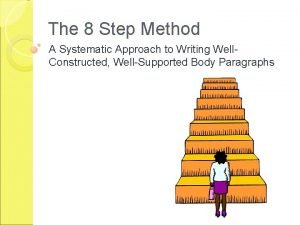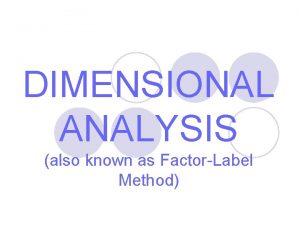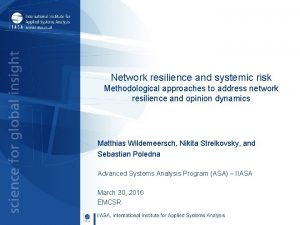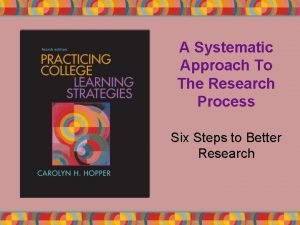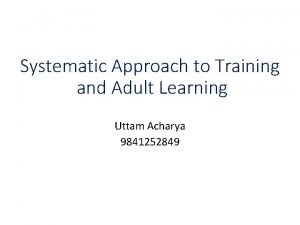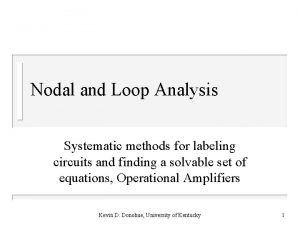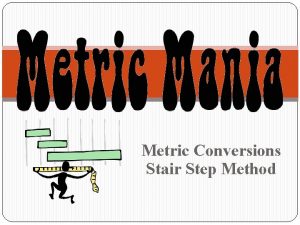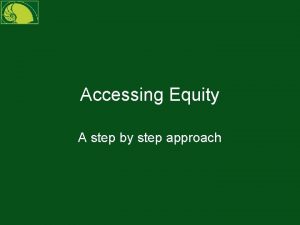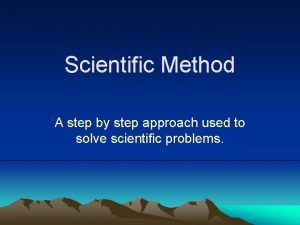The 8 Step Method A Systematic Approach to










- Slides: 10

The 8 Step Method A Systematic Approach to Writing Well. Constructed, Well-Supported Body Paragraphs

Step 1 – Topic Sentence MAKE YOUR POINT Express your point, idea, or opinion. Some people call the main sentence of a body paragraph a topic sentence. In a good intro paragraph, you have listed your main supporting ideas in the plan of attack. Every topic sentence of every body paragraph restates one of those main supporting ideas. Steps are very important in the transfer of power in Shakespeare’s Richard II.

Step 2 - Transition GET A TRANSITION Transition from your point to the evidence. A good transition is important because of a factor called coherence. Coherence is a glue that keeps an essay proceeding in logical fashion. Without good transitions, you might experience the misfortune of having someone call you incoherent. Steps are very important in the transfer of power in Shakespeare’s Richard II. For example,

Step 3 - Context REPORT THE CONTEXT Set up the context of your evidence. Context makes evidence more understandable. Think of context as providing the who, what, when, where, why, and/or how that surrounds the evidence. Think of the last time somebody told a friend of yours something you said as a joke but didn’t mention that you were joking—is it a good thing to be quoted out of context? Steps are very important in the transfer of power in Shakespeare’s Richard II. For example, as Henry Bolingbroke looks up at Richard II atop the castle wall and lays down his challenge,

Step 4 – Source (+ verb) IDENTIFY THE SOURCE Identify the source of your evidence. Evidence doesn’t come out of thin air. Some person or some character or some speaker in a poem—someone out there—is the source of the evidence you are presenting. To misidentify or, worse yet, to fail to identify the source is to weaken seriously, if not ruin, the effect of your evidence. Steps are very important in the transfer of power in Shakespeare’s Richard II. For example, as Henry Bolingbroke looks up at Richard II atop the castle wall and lays down his challenge, Bolingbroke’s chief assistant Northumberland yells up at Richard,

Step 5 - Evidence OFFER THE EVIDENCE Provide the evidence. In an analytic essay, the evidence is always either direct quotation, paraphrase, or summary. The best of those three is DIRECT QUOTATION. In a personal essay, the evidence is always personal anecdote – a relevant story from the experiences of your own life. Steps are very important in the transfer of power in Shakespeare’s Richard II. For example, as Henry Bolingbroke looks up at Richard II atop the castle wall and lays down his challenge, Bolingbroke’s chief assistant Northumberland yells up at Richard, “may it please you to come down”

Step 6 - Documentation PUT IN PARENTHETICAL DOCUMENTATION When appropriate, add documentation. Parenthetical documentation is ½ of the whole documentation picture. The other ½ is WORKS CITED. It is appropriate to add parenthetical documentation after direct quotation, paraphrase, and summary; and, of course, a WORKS CITED entry must work hand-in-hand with the parenthetical documentation. Steps are very important in the transfer of power in Shakespeare’s Richard II. For example, as Henry Bolingbroke looks up at Richard II atop the castle wall and lays down his challenge, Bolingbroke’s chief assistant Northumberland yells up at Richard, “may it please you to come down” (3. 3. 177).

Step 7 - Relevance EXPLAIN RELEVANCE OF EVIDENCE Explain the relevance, or importance, of your evidence. Evidence doesn’t speak for itself. Whether in a courtroom or in the marketplace of ideas, you must explain how the evidence you provide ties into and supports the main supporting idea in a specific body paragraph. Be sure to explain in detail. Steps are very important in the transfer of power in Shakespeare’s Richard II. For example, as Henry Bolingbroke looks up at Richard II atop the castle wall and lays down his challenge, Bolingbroke’s chief assistant Northumberland yells up at Richard, “may it please you to come down” (3. 3. 177). As he subsequently descends the steps, Richard is leaving his high position both literally and figuratively.

Step 8 - Proofread CHECK THE ACCURACY OF THE EVIDENCE Check the accuracy, or correctness, of your evidence. In an analytic essay, check the accuracy of the direct quotation, paraphrase, or summary. In a personal essay, check the accuracy of your memory or recollection. CHECK THE ACCURACY of evidence because flawed evidence can ruin the effectiveness of your idea. Steps are very important in the transfer of power in Shakespeare’s Richard II. For example, as Henry Bolingbroke looks up at Richard II atop the castle wall and lays down his challenge, Bolingbroke’s chief assistant Northumberland yells up at Richard, “may it please you to come down” (3. 3. 177). As he subsequently descends the steps, Richard is leaving his high position both literally and figuratively.

Hold on! How many sentences was that, exactly? . . . If you follow the 8 Step Method one time through completely, you should finish with 5 sentences: Topic sentence = 1 st sentence Transition + Context = 2 nd sentence Source (+verb) + Evidence + Documentation = 3 rd sentence Relevance = 4 th and 5 th sentences (or more) A well-developed paragraph has more than 5 sentences. What should you do? When developing a paragraph, follow Steps 1 -8, then repeat using Steps 2 -8. Your second time through Steps 2 -8 should use a different piece of evidence that also supports your main point in Step 1. This will give you a body paragraph with 9 or more sentences! Writing a full length essay? Repeat the entire process for the next paragraph.
 Step 1 step 2 step 3 step 4
Step 1 step 2 step 3 step 4 Coverdale systematic approach
Coverdale systematic approach Step-by-step method
Step-by-step method Dimensional analysis steps
Dimensional analysis steps Systematic approach to problem solving
Systematic approach to problem solving Network resilience a systematic approach
Network resilience a systematic approach Systematic name
Systematic name Systematic approach to research
Systematic approach to research Systematic approach to training
Systematic approach to training Solve the equation 2(x+8) = -x+20 by systematic method.
Solve the equation 2(x+8) = -x+20 by systematic method. Teeth disking
Teeth disking


